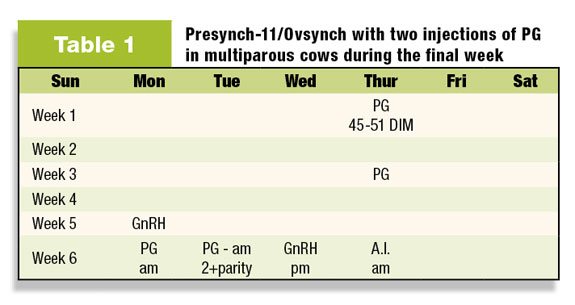Many dairy veterinarians prescribe the use of prostaglandin F2α (PG) in dairy herds to control time to estrus (heat), as part of synchronization programs or for postpartum treatments. There are two primary PG products available in the U.S., dinoprost tromethamine (Lutalyse and generic ProstaMate) and cloprostenol sodium (Estrumate and generic estroPLAN). These two products are different in chemical structure and have a different half-life. Cloprostenol has a longer half-life than dinoprost, and thus is maintained in circulation for a longer time. But are they different when it comes to performance in the field? We have completed several studies that indicated there were subtle differences. This article will discuss the pros and cons of these two products.
Prostaglandin 101
Both dinoprost and cloprostenol are designed to do the exact same thing: regress the corpus luteum (CL). The CL is the transient progesterone-producing organ in the ovary that is primarily responsible for the maintenance of pregnancy, but it is also necessary for a normal-length estrous cycle.
When the CL is regressed using PG, progesterone decreases to basal levels in lactating dairy cows in approximately 30 hours. Once progesterone is no longer in the cow’s circulatory system, the cow may be in standing heat when the ovulatory follicle is mature enough to produce sufficient quantities of estrogen to cause standing heat behavior. This is usually no sooner than 30 hours after complete CL regression.
So, if there are functional CL present in the ovaries at time of treatment, lactating dairy cows will not show signs of heat for about 2.5 days after a PG injection. Most cows that display standing heat on day one or two following PG treatment are not in heat due to the PG.
They most likely had CL regression prior to the treatment and were experiencing a normal heat (not due to the PG). Also, PG does not directly cause a cow to come into heat. It allows the process to materialize through the elimination of the CL. Yet one of these products may enhance concentrations of estrogen following treatment that, in turn, may cause more cows to show signs of heat.
One word of caution with PG: Do not use either product in cows that are pregnant or may be pregnant. It will eliminate the CL that is necessary for maintenance of early pregnancy and will cause the loss of the embryo/fetus.
Effectiveness of CL regression
In a study published last year, 25 mg (5 ml) dinoprost and 500 μg (2 ml) cloprostenol performed the same in lactating dairy cows when it came to the percentage of cows with complete CL regression by 56 hours after treatment.
Both products caused approximately 80 percent of cows to have CL regression following the final PG dose of a Presynch/Ovsynch program. The most interesting aspect of this measurement was the 20 percent that did not have complete CL regression. The likelihood of a pregnancy of the cows that did not regress by our definition was near 0 percent.
So, it is critical that cows have complete regression in order to become pregnant following Ovsynch preceded by a pre-synch program (Presynch-11, G6G or Double Ovsynch). In this study, first-lactation cows were more likely to have CL regression following the final PG dose of Ovsynch. The problematic cows were the second-lactation-plus cows.
The solution to this problem may come from a study by Milo Wiltbank’s lab at the University of Wisconsin – Madison in which cows were administered dinoprost at the final PG dose of the Double-Ovsynch program, and then half of the cows received a second dinoprost 24 hours later.
The final GnRH was 56 hours after the initial PG dose. Luteolysis was enhanced significantly in the cows that received the second dose of PG (96 vs 85 percent) and subsequently conception rates were three percentage points greater.

We calculated the value of this second injection using the UW-DairyRepro$ calculator with a conservative cost of $3 for the second dose of PG. The benefit was $0.03 per cow per day or approximately $13,000 per year for a 1,000-cow dairy. We would, however, recommend the second injection only for second-lactation-plus cows. (See Figure 1 ). Either product, in this case, will work similarly.
Expression of estrus and conception rates
There may be differences, however, in the ability of these two products to initiate a cascade of events that allows more cows to exhibit behavioral signs of estrus. In another study, cloprostenol induced a faster decrease in progesterone during the first 12 hours after injection compared to dinoprost.
This faster drop in progesterone in the cloprostenol group enhanced the amount of estrogen produced by the pre-ovulatory follicle likely due to greater pulses of the hormone LH that drives the growth of follicles.
In all cows in this study, and in other studies, the faster the drop in progesterone the greater the concentrations of estrogen in circulation. Researchers found that the greater the estrogen at time of final GnRH of the Presynch/Ovsynch protocol, the greater the chance for pregnancy.
This cause-effect action of cloprostenol held up in a very large (n=4, 549 cows) field study due to be published later this year. First-lactation cows 60 to 66 DIM were more likely to be detected in estrus due to treatment with cloprostenol compared to dinoprost (42 vs 34 percent).
In the same study, cows treated with cloprostenol had greater conception rates compared to dinoprost (38 vs 34 percent) in the 80 percent of cows that were inseminated on days three and four following treatment. Based on our previous studies, these cows most likely had the CL needed to have the more rapid drop in progesterone and the dominant follicle needed to have a more rapid increase in estrogen.
This translated into greater pregnancy rates in first-lactation cows treated with cloprostenol compared to dinoprost. There was no difference between products in any of these measurements in second-lactation-plus cows.
In summary, both products perform similarly in lactating dairy cows when it comes to complete CL regression – but it appears that cloprostenol has an advantage when it comes to percentage of first-lactation cows detected in heat and conception rates following a detected heat. PD
References omitted due to space but are available upon request. Click here to email an editor.

J. Richard Pursley
Professor
Department of Animal Science
Michigan State University






